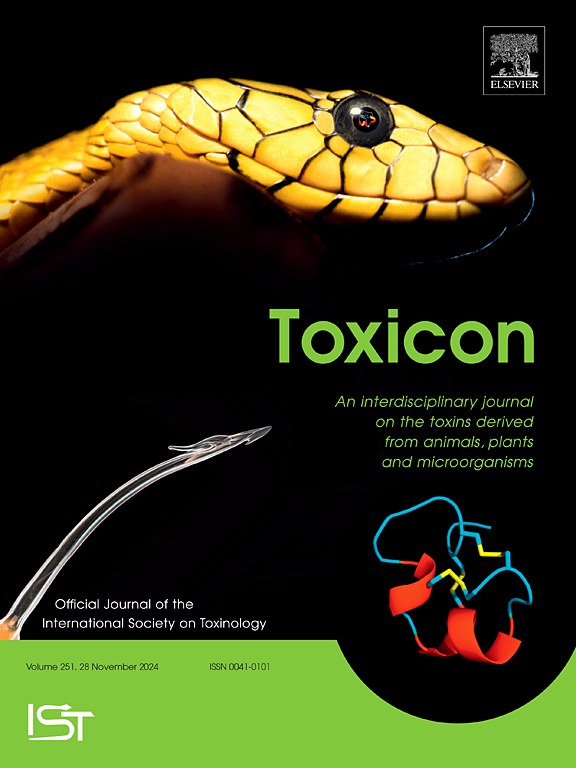吸血蝙蝠源性CGRP在爪蟾卵母细胞系统中人CGRP受体上的药理特性。
IF 2.4
4区 医学
Q2 PHARMACOLOGY & PHARMACY
引用次数: 0
摘要
吸血蝙蝠(Desmodus rotundus)有一个由下颚腺组成的口腔毒液系统,可以产生生物活性化合物,通过锋利的门牙传递给猎物。长期以来,人们一直认为这种毒液具有抗凝血和蛋白水解的特性,这些特性会破坏血块的形成,干扰凝血级联反应。一种结构与人类降钙素基因相关肽(hCGRP)高度相似的肽是一种有效的血管扩张剂,最近在圆齿蛇毒中发现。该吸血蝙蝠源性CGRP (vCGRP)可诱导预收缩大鼠肠系膜动脉松弛,其疗效和效力与hCGRP相当。作者提出vCGRP通过激活CGRP受体(CGRPR)和电压依赖性钾(Kv)通道介导血管松弛,从而通过持续的血流增强血粉吸收。我们的研究建立在这些发现的基础上,通过证明vCGRP是hCGRPR的有效激动剂,并激活G蛋白偶联的内向整流钾(GIRK1/2)通道。虽然观察到的GIRK1/2激活与可能支持血管舒张的膜超极化机制一致,但我们的发现并不能直接证明血管舒张。相反,他们提供了vCGRP-CGRPR信号和下游gpcr离子通道激活的详细功能评估。值得注意的是,从这里研究的系统中,我们没有发现Gs或Gq蛋白,也没有Kv通道参与这一信号通路。vCGRP的效价为9 nM,是一种高效的模拟物,可以特异性地和有效地与猎物中的CGRPR发生作用。本文章由计算机程序翻译,如有差异,请以英文原文为准。

Pharmacological characterization of vampire bat-derived CGRP at the human CGRP receptor in the Xenopus oocyte system
Vampire bats (Desmodus rotundus) possess an oral venom system consisting of submandibular glands that produce bioactive compounds, delivered to prey via their sharp incisors. The venom has long been recognized for its anticoagulant and proteolytic properties, which disrupt blood clot formation and interfere with the coagulation cascade. A peptide with high structural similarity to human calcitonin gene-related peptide (hCGRP), a potent vasodilator, was recently discovered in the venom of Desmodus rotundus. This vampire bat-derived CGRP (vCGRP) elicited relaxation of pre-contracted rat mesenteric arteries, displaying efficacy and potency comparable to hCGRP. The authors proposed that vCGRP mediates vasorelaxation through activation of CGRP receptors (CGRPR) and voltage-dependent potassium (Kv) channels, thereby enhancing blood meal absorption via sustained blood flow. Our study builds on these findings by demonstrating that vCGRP is a potent agonist of hCGRPR and activates G protein–coupled inwardly rectifying potassium (GIRK1/2) channels. While the observed GIRK1/2 activation is consistent with membrane hyperpolarization mechanisms that may support vascular relaxation, our findings do not directly demonstrate vasodilation. Instead, they provide a detailed functional assessment of vCGRP–CGRPR signaling and downstream GPCR-ion channel activation. Notably, from the system studied here we found no involvement of Gs or Gq proteins, nor of Kv channels, in this signaling pathway. With a potency of 9 nM, vCGRP represents a highly effective mimic evolved to specifically and potently engage CGRPR in prey.
求助全文
通过发布文献求助,成功后即可免费获取论文全文。
去求助
来源期刊

Toxicon
医学-毒理学
CiteScore
4.80
自引率
10.70%
发文量
358
审稿时长
68 days
期刊介绍:
Toxicon has an open access mirror Toxicon: X, sharing the same aims and scope, editorial team, submission system and rigorous peer review. An introductory offer Toxicon: X - full waiver of the Open Access fee.
Toxicon''s "aims and scope" are to publish:
-articles containing the results of original research on problems related to toxins derived from animals, plants and microorganisms
-papers on novel findings related to the chemical, pharmacological, toxicological, and immunological properties of natural toxins
-molecular biological studies of toxins and other genes from poisonous and venomous organisms that advance understanding of the role or function of toxins
-clinical observations on poisoning and envenoming where a new therapeutic principle has been proposed or a decidedly superior clinical result has been obtained.
-material on the use of toxins as tools in studying biological processes and material on subjects related to venom and antivenom problems.
-articles on the translational application of toxins, for example as drugs and insecticides
-epidemiological studies on envenoming or poisoning, so long as they highlight a previously unrecognised medical problem or provide insight into the prevention or medical treatment of envenoming or poisoning. Retrospective surveys of hospital records, especially those lacking species identification, will not be considered for publication. Properly designed prospective community-based surveys are strongly encouraged.
-articles describing well-known activities of venoms, such as antibacterial, anticancer, and analgesic activities of arachnid venoms, without any attempt to define the mechanism of action or purify the active component, will not be considered for publication in Toxicon.
-review articles on problems related to toxinology.
To encourage the exchange of ideas, sections of the journal may be devoted to Short Communications, Letters to the Editor and activities of the affiliated societies.
 求助内容:
求助内容: 应助结果提醒方式:
应助结果提醒方式:


